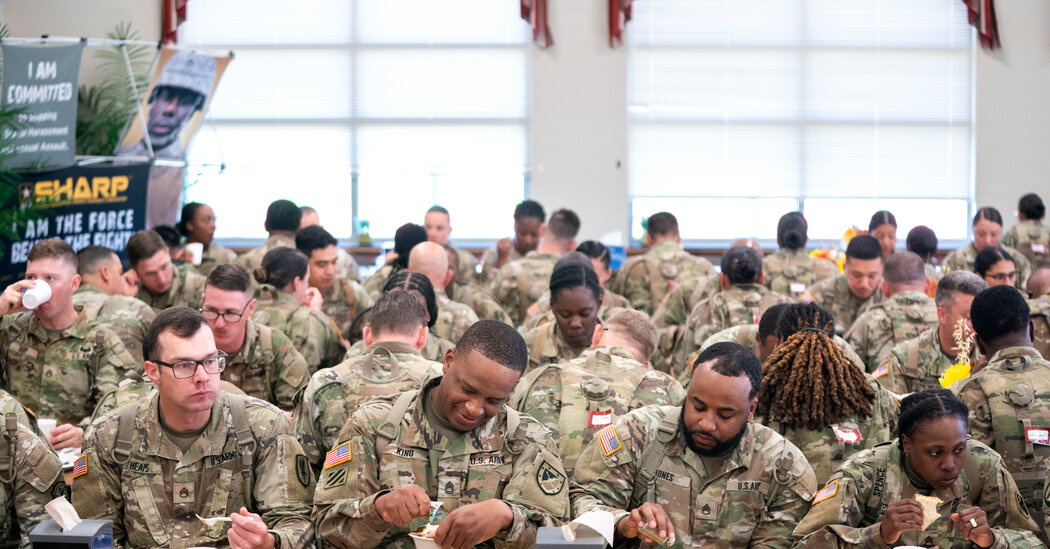
Can the Army Make Food Its Soldiers Want to Eat?
Army food has been vexing and perplexing the soldiers who have to eat it for about as long as there’s been an Army. An age-old marching song describes a biscuit that “rolled off the table and killed a friend of mine.” Troops in World War II immortalized a much-reviled beef dish with the nickname S.O.S., an acronym that still can’t be translated in this newspaper.
And at lunchtime on a recent Wednesday, a mess hall at Fort Jackson in South Carolina was serving up tacos filled with nondescript meat that glistened with grease. The brussels sprouts had the green boiled out of them. The hall itself looked bland and dated.
But just steps away at Victory Fresh, a small, sleek fast-casual cafeteria that shares the mess-hall kitchen, cooks were pulling individual-size pizzas from a $45,000 Marra Forni oven. The brisket had been cured and charred on-site, then carved to order. Dessert included narrow wedges of cheesecake, marbled missiles of sweet cream cheese cut with bitter chocolate.
The celebrity chef Robert Irvine, who opened Victory Fresh last year, was finishing his lunch when a towering figure in fatigues marched up. The soldier, who introduced himself as Sgt. Major Joshua R. Bitle, declared that in 28 years in the military, he’d never eaten as well as he just had.
Then a note of exasperation entered the sergeant’s voice. Why, he asked, wasn’t there a Victory Fresh on every base? “Nobody has given me an explanation for why we can’t do it.”
Mr. Irvine, the onetime star of the Food Network shows “Dinner: Impossible” and “Restaurant: Impossible,” knows what those explanations might be: logistics, funding, institutional inertia. But he thinks the moment is finally right to change the Army’s food culture. And the Army has decided that he is the man to lead that charge.
For the past year, he’s been an unpaid special consultant, a civilian given rare influence over policy, acting as the face and guiding spirit of what the Army is calling a “generational overhaul” of its feeding operations.
Mr. Irvine, 59, looks the part, with muscles rippling beneath a fitted T-shirt and a high-and-tight haircut like a fresh recruit’s. Preternaturally energetic, he seems to mostly live on a Praetor 600 jet, flying from base to base to spread the gospel of good eating.
“The senior leadership is ready to listen,” he said, “because they know it’s a problem.”
About 70 percent of all active-duty service members are overweight, and 21 percent are obese, according to a 2023 report by the American Security Project, a military think tank. Recipes at the official dining facilities (better known as DFACs, or “warrior restaurants”) are rigidly codified to meet various nutritional standards, but many soldiers find the results so unappetizing that they eat instead at fast-food restaurants on and off the base.
“The most frequent and concerning issue we see is raw or undercooked chicken,” Robert Evans, an Army veteran whose website Hots & Cots collects reviews of dining and housing on U.S. military bases, wrote in an email. “There are also occasional reports of things like moldy bread, expired dairy, or poorly prepared meals.”
This is far from the first attempt to improve military meals, but it may be the most ambitious.
The initial step was opening the Victory Fresh at Fort Jackson and a similar cafeteria at Joint Base Andrews in Maryland. Now the Army is starting to transform dining halls, at five of its biggest U.S. bases, into something more like Victory Fresh, on a larger scale. If those succeed, the Army will eventually revamp more than 100 mess halls at 35 domestic and foreign installations.
The goal is to make the food so delicious and convenient (with food trucks and possibly online ordering and delivery) that soldiers stop dreaming of fast food.
Perhaps the biggest change will be the staffing. The soldiers who now cook in those dining halls will be replaced by civilians, hired by private contractors who will run the kitchens. That will free up the cooks for tasks more central to soldiering, said Kimberly A. Hanson, an Army spokeswoman.
Can this effort succeed where others have failed?
Although Health Secretary Robert F. Kennedy Jr. talks about healthy diets and Defense Secretary Pete Hegseth has made soldiers’ physical fitness a top priority, Mr. Hegseth has also proposed big military budget cuts for the next five years. Ms. Hanson said, “We do not anticipate Chef Irvine’s work in support of the Army to be impacted.”
William H. Dietz, a former top obesity expert at the Centers for Disease Control and Prevention, sees another hurdle. “What the chef is proposing is terrific,” he said. “The challenge is that he has to change the culture.”
Up Through the Ranks
The day Mr. Irvine visited the Victory Fresh at Fort Jackson, a rotisserie oven that had gone unused was turning out citrus-and-herb-brined chicken, accompanied by a proprietary “hen sauce” — a mix of chicken and beef gravy with caramelized onions, apple cider vinegar and “a touch of heavy cream,” said Shane Cash, a former Marine who is now a vice president of Robert Irvine Foods. (Victory Fresh doesn’t sell the company’s products, he said.)
Each day, Victory Fresh offers one of five rotating dishes: pulled pork; turkey kielbasa; turkey meatloaf with collard greens; dry-rubbed ribs; and brisket. That sounds like a lot of saturated fat and calories, but Mr. Cash said a profusion of Sweetgreen-style salad bowls, wraps and deli sandwiches more than balances it out. Victory Fresh also opts for more nutritious ingredients whenever possible, he said — for example, using whole-grain pasta in its mac and cheese.
The cafeteria serves about 400 people a day, said officials at Fort Jackson, where 3,500 soldiers are stationed and about as many civilians work. At the height of the lunch rush, a line often spills out the door. (The place is closed for dinner.)
Mr. Irvine has delegated the details of the Army overhaul to his Robert Irvine Foundation, which provides food and support services for soldiers and veterans. Its chief operating officer, Justin Leonard, praised Army officials for granting his team considerable freedom so far — allowing them, for example, to order ingredients from food distributors that hadn’t been approved by the Pentagon’s Defense Logistics Agency.
“Procurement is the cornerstone of all of this,” Mr. Leonard said. “If we can’t get our cooks the freshest, most nutritious ingredients consistently, then none of this can work.”
Mr. Irvine has long been an evangelist for improving food in the military. Born into a working-class English family, he was trained in the 1980s as a cook in the Royal Navy — his only formal culinary education.
In 1996, he moved to the United States, running all the restaurants at the Trump Taj Mahal in Atlantic City, N.J. He went on to host the Food Network series “Dinner: Impossible,” but was dropped in 2008 after admitting that he had fabricated items on his résumé, including a claim that he helped bake the wedding cake for Prince Charles and Lady Diana. Plans for two Florida restaurants collapsed. So did his marriage.
Mr. Irvine eventually returned to television and remarried. When he heard in 2023 that the Army was rethinking its food operations, he asked to play a major role. Last year, his work feeding soldiers was praised by First Lady Jill Biden at a White House event. Mr. Irvine also runs Fresh Kitchen, the only full-service, sit-down restaurant at the Pentagon.
He bristles at the suggestion that his military work is a redemption project. “I make no bones about making a mistake. I own that,” he said in a phone interview from Puerto Rico, where he joined in a National Guard event after visiting troops in Norway.
Working with soldiers, he said, “invigorates me every day.”
Looking for Lessons
To show Army officials how to scale up his ideas, Mr. Irvine took several of them last spring to Columbia University, which he said “had the best food of any university on this planet.” He and others credit Vicki Dunn, Columbia’s assistant vice president for dining. Arriving on campus in 2007, she quickly set about transforming the dining halls, with an emphasis on freshness and variety.
Ms. Dunn said she retains about 87 percent of students on a meal plan after their freshman year, when they are no longer required to buy one. She insists the Army can replicate that. “It’s not that hard,” she said.
Military cuisine is in constant conversation with its civilian counterpart, said Anastacia Marx de Salcedo, the author of “Combat-Ready Kitchen: How the U.S. Military Shapes the Way You Eat.”
The Recommended Dietary Allowances that set nutritional guidelines for Americans were developed in 1943 for troops fighting in World War II. In 2008, the military adopted Go for Green, a color-coded guide for each dish — Eat Often (green), Eat Occasionally (yellow) and Eat Rarely (red) — that was posted in cafeterias.
“This approach was actually ahead of the curve in the U.S.,” Ms. Marx de Salcedo said. But a Government Accountability Office report last year found that the labeling system had been poorly implemented, with labels at many cafeterias “missing, not standardized or improperly placed.”
Efforts to get soldiers to eat healthier have also been hindered by the military’s embrace of fast food.
In 1984, Burger King signed a deal with the Pentagon to open 185 outlets at domestic and international installations. One awaits recruits at Fort Jackson, as do a Panda Express, a Pizza Hut and a Subway. The base is ringed by even more fast food restaurants.
“We don’t want them going to Burger King every day for a meal,” said Lt. Gen. Christopher O. Mohan, deputy commanding general of the Army’s Materiel Command, and one of the top officials running the food upgrade. “We’ve got to do better than that.”
Changing of the Guard
Turning soldiers into cooks has also been tricky. They are often thrust into the role of “culinary specialist” without any experience or much desire to cook. Those who know their way around a kitchen may shy away from a job that requires them to follow recipe cards.
As soldiers are increasingly replaced by contractors, there will be fewer opportunities for Army cooks to shine.
“Some are talented, motivated and see military food service as a steppingstone to a culinary career after service,” said Mr. Evans, the Hots & Cots editor.
The breadth of the Army’s culinary talent was on spectacular display this month at Fort Gregg-Adams in Virginia, which hosted an international competition of military cooks. Among them were soldiers from Fort Cavazos in Texas who used rudimentary equipment to make a four-course meal that included Dover sole with Parmesan sauce.










